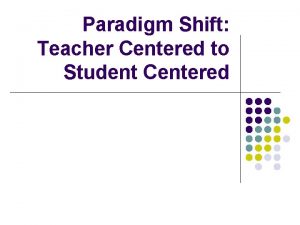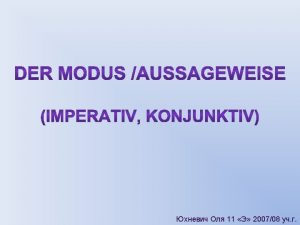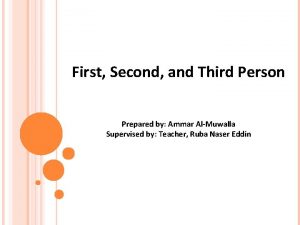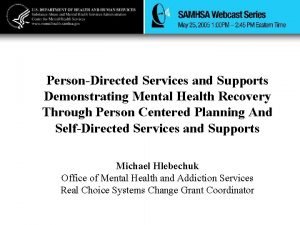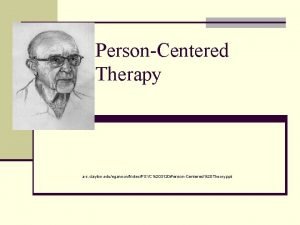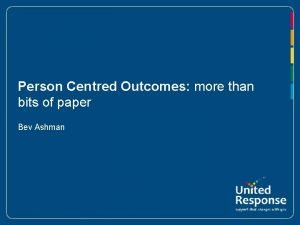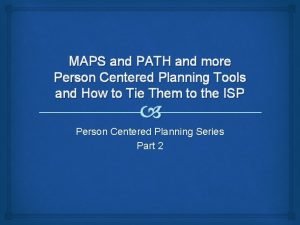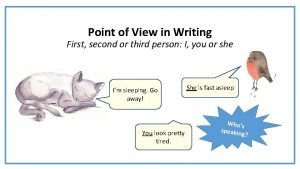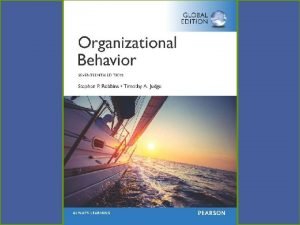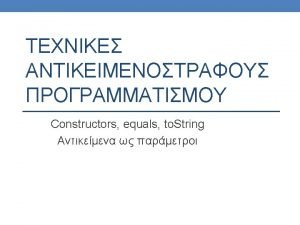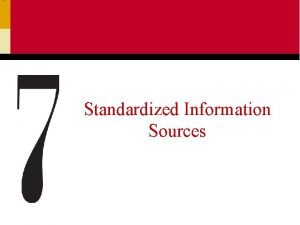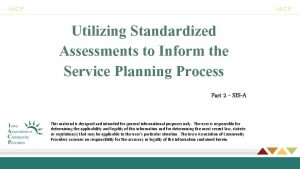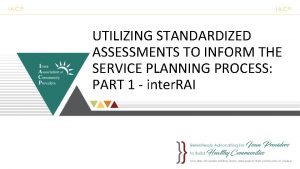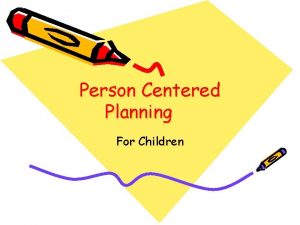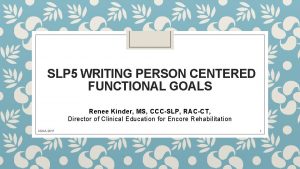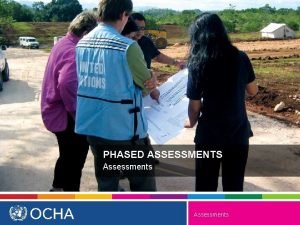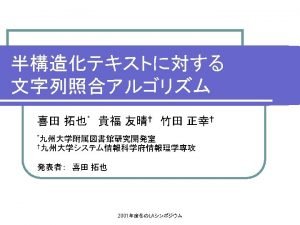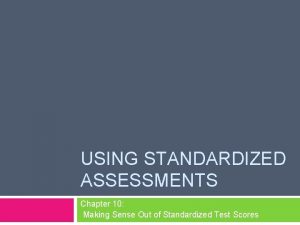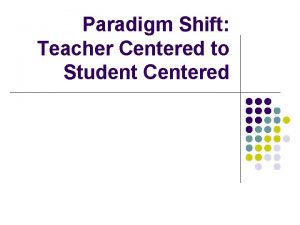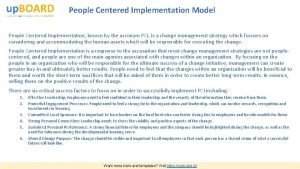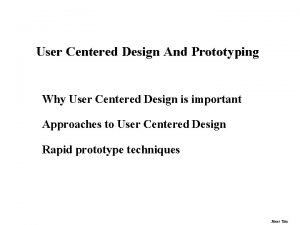Using Standardized Functional Assessments to inform Person Centered





















- Slides: 21

Using Standardized Functional Assessments to inform Person. Centered Planning INTELLECTUAL/DEVELOPMENTAL DISABILITIES AND THE SUPPORTS INTENSITY SCALE(SIS)

Objectives � To explain how we use the Supports Intensity Scale (SIS) to assist in person centered planning process(PCP). � To describe the process we will use to establish service array guidelines for appropriate levels of supports. � To aid in providing consistent levels of supports across the arrays across the Lakeshore Regional Entity’s CMHSPs and to assist with allocating resources in an equitable manner at system, agency, and individual levels. � To coincide with Michigan’s new Parity standards

The SIS®, Service Array Guidelines, and the PCP � The LRE utilizes standardized functional assessments such as the SIS® and the authorization decision guidelines to support and inform the person-centered planning process. � The SIS® assists with informing the needs and strengths of individuals, however the final service delivery will be based on an individual’s unique circumstances and directed by the PCP. � The results of the SIS® and the service array guidelines will be used as part of the person centered planning process to develop goals as well as assist with long term strategic planning and resource allocation. � Finally, the goal of the SIS® is to protect service delivery for people with intellectual and/or developmental disabilities, while also providing our service system with the necessary guidance to assess, measure, and determine recommended services that support the Person-Centered Plan.

The SIS® � The Supports Intensity Scale (SIS®) is a strength-based assessment tool created by the American Association on Intellectual and Developmental Disabilities (AAIDD). � The SIS is required by the Michigan Department of Health and Human Services (MDHHS) for individuals age 18 or older who have an intellectual or developmental disability and who receive services from Prepaid Inpatient Health Plans (PIHP). � Administered once every 3 years or sooner if there is a substantial life change. � Intended use is to inform the person-centered planning process. � Made up of three sections which evaluate the support needs of a person with an intellectual or developmental disability to lead a life as independently as possible

Utilization of the SIS® � “The SIS provides a consistent methodology for assessing an individual’s support needs which can then be considered in addition to personal preferences, natural supports and service settings. ” � “The SIS provides valuable guidance to programs and payers in considering a typical range of services for individuals with similar support needs but cannot be used as the sole instrument for determining the need for supports and services” Jeff L. Wieferich - Director Bureau of Community Based Services, MDHHS

Service Array Guidelines � The LRE has developed service array guidelines for specific services that correlate to the needs of individuals based upon the results of the standardized functional assessments such as the SIS®. � The service array range will be identified at the time of the psychosocial assessment and/or review of the standardized functional assessment. This information will inform the PCP Process, where the needs of the individual and the appropriate service array will be further refined including optimizing natural and community supports.

Service Array Development � A random sample was used for array development. � The Lakeshore Regional Entity (LRE) developed 7 service arrays for the adult IDD population. � Service arrays were developed using information from the Supports Intensity Scale (SIS®) in an effort to group individuals together who likely have similar support needs. � Extraordinary medical and behavioral support needs as well as supports in the areas of Home Living, Community Living, and Health & Safety are used to assess support needs across service arrays. The absence of the support would result in extreme emotional or physical harm. � Service Array descriptions were developed to provide a narrative of the level and type of support typically needed for individuals within each service array.

Example: Array 1 a �Mild Support Needs, no to few Behavioral or Medical indicators. Or someone who has not had a SIS completed. . Sum of Parts A, B and E Medical Needs Behavioral Needs 0 -20 0 -5 � Authorization maximum for Community Based Services Living in licensed home or has a daily per diem CLS rate (H 0043) � 0 hours of combined weekly support Living in unlicensed home (with family, housemates, etc. ) � 0 -10 hours of combined weekly support

Assessment and Service Arrays to inform the Person-Centered Planning Process �During the PCP meeting: The SC/CSM engages a group discussion regarding a person’s identified needs and collectively develops achievable goals and objectives. Exploration of community resources and natural supports available to the person are considered first. Identified needs that are not met by the natural and community support system may be eligible for CMHSP service coverage in accordance with the LRE service array, as Medicaid is the provider of last resort If after all sources are exhausted and the unmet needs fall outside of the service array range, the primary clinician will follow the exception process.

Exception Request Process � The LRE recognizes that the needs of the individuals and families served are unique and not all needs can be met by the amount, scope, duration, and type of services as identified in the service arrays. Therefore, the LRE has developed an exception request review procedure outlined below to ensure that individuals have access to all medically necessary services in the amount, scope, duration needed to reasonably achieve the goals in their Individual Plan of Service (IPOS).

Exception Request Process cont. � Should an individual request services that fall outside the recommended service array ranges, an exception request will be submitted to the identified CMHSP reviewer, in writing, which specifies extenuating circumstances (e. g. risk to the person’s supports system, health, personal safety, and preservation of current living situation) and the additional amount/scope and duration requested. � The identified CMHSP reviewer shall be an individual who was not involved in the initial service recommendation. � The CMHSP reviewer will examine available resources, the IPOS, the level of natural supports, and other pertinent information and determine if the exception will be approved

Mental Health Parity Standards � Mental health parity describes the equal treatment of mental health conditions and substance use disorders in insurance plans. When a plan has parity, it means that if you are provided unlimited doctor visits for a chronic condition like diabetes then they must offer unlimited visits for a mental health condition � On September 26, 1996, Congress enacted the Mental Health Parity Act of 1996 (MHPA), which required parity in aggregate lifetime and annual dollar limits for mental health benefits and medical/surgical benefits. The Balanced Budget Act of 1997 (BBA) generally applied certain aspects of MHPA to Medicaid Managed Care Organizations and CHIP benefits

Mental Health Parity Standards � The PIHP system including LRE will have to make changes to how home and community based services are identified for individuals to ensure compliance with parity. Currently, supports and services are decided based on medical necessity as it is defined in the Medicaid Provider Manual and there is significant variability in how medical necessity criteria are applied. � The LRE needs to have a more standardized process for making these determinations to follow parity. The specialty behavioral health system utilizes several standardized assessment instruments to gather information and assist in determining level of care and support and service needs. � In order to establish a more standardized process, the LRE will develop a range or group of services that equate with a score that is obtained from the standardized assessment. This range or service group will serve as a starting point in determining the supports and services that an individual needs. � Services to persons with I/DD will eventually be included in these standards.

How will this impact the services I receive? � Standardized functional assessments, such as the SIS® and the authorization decision guidelines will support and inform the personcentered planning process. � Will allow for standardization of the processes throughout the state and region and foster fair and consistent distribution of resources.

What does the SIS/LRE Service Arrays Do? �Focuses on the support needs of an individual rather than his/her deficits. �It evaluates the pattern and intensity of needed supports in six life domain activities that are common to everyone regardless of disability. �It is used as part of Person Centered Planning to develop goals as well as assist with long term strategic planning and resource allocation. �Instills confidence that the assessment and Individual Plan of Service developed through the Person Centered Planning process will promote services and supports consistent with individual need.

What doesn’t the SIS/LRE Service Arrays do? �Does not determine the Person Centered Plan �Does not definitively determine services based on array. �Does not negate clinical judgment. �Does not replace the Person Centered Preplanning tool but rather is used in conjunction with it. �Is not to be used as a mechanism to balance the CMH budgets.

Summary of Surveys �Survey information was sent to guardians/families and Providers starting November, 2018. �The survey could be accessed through a survey monkey. �The link to the survey was emailed and was also available on the LRE website as well as some of the CMH websites. �The survey could also be completed in writing. �We had 188 responses for the guardian/family survey �We had 135 responses for the provider survey �We had 95 responses for the consumer survey

Guardian/Family Survey Guardian and Family Members Survey Percent Agree It is useful to understand the needs and strengths of a person with intellectual and/or developmental disabilities when determining which services and supports they should receive It is useful to understand needs and strengths of a person with intellectual and/or developmental disabilities when determining the amount of services and supports they should receive It is useful to have valid and reliable assessments to help gauge the services and support needs of a person with intellectual and/or developmental disabilities It is important that areas such as home living, community living, lifelong learning, employment, health and safety, social activities, and protection and advocacy be addressed when evaluating the service and support needs of a person with intellectual and/or developmental disabilities It is important that both behavioral and medical health issues are considered when determining the service and support needs of a person with intellectual and/or developmental disabilities It is important to understand aspects of a person’s life experience both in those areas that are currently functioning well and those that need attention when determining the service and support needs of a person with intellectual and/or developmental disabilities It would be useful to have guidelines on services and support levels based on valid and reliable assessment of a person with intellectual and/or developmental disabilities Percent Disagree 99. 36% 0. 64% 98. 71% 1. 29% 96. 10% 3. 90% 98. 72% 1. 28% 99. 35% 0. 65% 94. 63% 5. 37%

Provider Survey Percent Agree It is useful to understand the needs and strengths of a person with intellectual and/or developmental disabilities when determining which services and supports they should receive Percent Disagree 99. 3% 0. 7% 93. 9% 6. 1% It is important that areas such as home living, community living, lifelong learning, employment, health and safety, social activities, and protection and advocacy be addressed when evaluating the service and support needs of a person with intellectual and/or developmental disabilities 97. 7% 2. 3% It is important that both behavioral and medical health issues are considered when determining the service and support needs of a person with intellectual and/or developmental disabilities 99. 2% 0. 8% 86. 9% 13. 1% It is useful to understand needs and strengths of a person with intellectual and/or developmental disabilities when determining the amount of services and supports they should receive It is useful to have valid and reliable assessments to help gauge the services and support needs of a person with intellectual and/or developmental disabilities It is important to understand aspects of a person’s life experience both in those areas that are currently functioning well and those that need attention when determining the service and support needs of a person with intellectual and/or developmental disabilities It would be useful to have guidelines on services and support levels based on valid and reliable assessment of a person with intellectual and/or developmental disabilities

Consumer Survey Percent Agree It is useful to understand the needs and strengths of a person with intellectual and/or developmental disabilities when determining which services and supports they should receive Percent Disagree 97. 8% 2. 2% It is useful to understand needs and strengths of a person with intellectual and/or developmental disabilities when determining the amount of services and supports they should receive It is useful to have valid and reliable assessments to help gauge the services and support needs of a person with intellectual and/or developmental disabilities 100% 0% 96. 7% 3. 3% It is important that areas such as home living, community living, lifelong learning, employment, health and safety, social activities, and protection and advocacy be addressed when evaluating the service and support needs of a person with intellectual and/or developmental disabilities 100% 0% It is important that both behavioral and medical health issues are considered when determining the service and support needs of a person with intellectual and/or developmental disabilities 100% 0% 99. 0% 1. 0% 94. 4% 5. 6% It is important to understand aspects of a person’s life experience both in those areas that are currently functioning well and those that need attention when determining the service and support needs of a person with intellectual and/or developmental disabilities It would be useful to have guidelines on services and support levels based on valid and reliable assessment of a person with intellectual and/or developmental disabilities

Using Standardized Functional Assessments to Inform Person -Centered Planning Questions?
 Paradigm shift teacher-centered to student-centered
Paradigm shift teacher-centered to student-centered 2. person singular
2. person singular 3rd person point of view drawing
3rd person point of view drawing Person person = new person()
Person person = new person() First person second person third person chart
First person second person third person chart Person-centered plan goal examples
Person-centered plan goal examples Person-centered isp example
Person-centered isp example Reality therapy ppt
Reality therapy ppt Person centered planning tools
Person centered planning tools What is person centered
What is person centered Chapter 23 using recipes answer key
Chapter 23 using recipes answer key Transpalatal arch space maintainer
Transpalatal arch space maintainer Non functional plasma enzyme example
Non functional plasma enzyme example Functional and non functional plasma enzymes
Functional and non functional plasma enzymes Functional and non functional
Functional and non functional Formal and informal writing examples
Formal and informal writing examples First person vs third person writing
First person vs third person writing Person-job fit and person-organization fit
Person-job fit and person-organization fit What was montag's internal conflict
What was montag's internal conflict Public class person private name
Public class person private name When a person is logrolled the person is
When a person is logrolled the person is Language features of biography
Language features of biography
